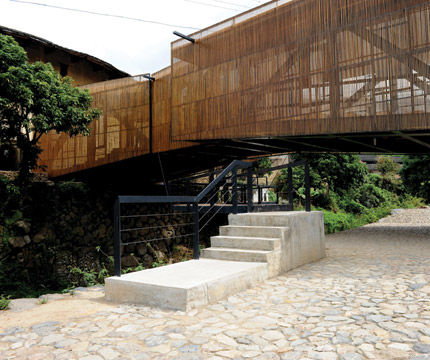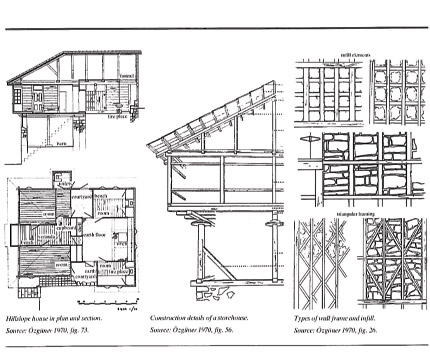AN AGA KHAN CONFERENCE
| February 28, 2011 | Post In LEAP 7
Beginning on October 19, 1981, a four-day conference for the sixth Aga Khan Award for Architecture was held in Beijing. The topic of discussion was “The Changing Rural Habitat,” which remains a meaningful and relevant topic to this day. The conference was divided into two components. The first presented case studies: “Rural Architecture in the Yemen Arab Republic,” “Cave Dwellings of Henan,” “Socialist Village Experience in Algeria,” and so on. The second component explored technological resources, with presentations on “Rural Methane Use in China,” “Earthquake and Rural Construction,” “Research on Mud as a Traditional Building Material,” and other fields of research. Participants included architects, planners, historians, anthropologists, sociologists, and experts on Islam, as well as doctors, writers, imams and other leading figures from all over the world. The participants aimed to implement academic research at a fundamental level, building from a wide variety of angles and perspectives.

In architectural historian Brian Bruce Taylor’s preface to the conference, he stated, “The present theme, ‘Changing Rural Habitat,’ was chosen as a focus for deliberation partly because the 1980 Awards had underlined the importance of changes taking place in the rural environment, and partly because the design profession in developing countries has had difficulty in defining the relevant roles it might play in solving rural problems.” The rural question has long been a major issue for the developing world. Compared to the early years of China’s development, rural construction methods have improved considerably. Interestingly, writer and doctor Elisabeth Comber, who played witness to the living conditions of rural pre-Liberation China, was invited to join the conference and give a speech for its opening. Although she did not come from the architecture world, she had rigorous experience engaging with issues of energy, housing, medicine, and education. In her opening speech, she referred to how “peasants refuse to live in high-rise buildings,” and “prefer the appearance of their courtyard-style homes, which boast a history of over 2500 years.” Looking back today, it’s hard not to find this ironic.
Trying to relate the greater conditions of China in 1981 to the Aga Khan Architectural Award conference can be rather puzzling. Its impact on history may seem quite minor, as the public barely recalls it ever happening. Yet then again, looking at the individuals who participated in the conference, China’s government at the time gave the event strong support. There were plenty of Chinese officials at the conference, such as the deputy governor of Jiangsu Province, the director of the China Architectural Council, Professor Yang Tingbao, and the director general of the State Capital Construction Committee’s Seismological Engineering Bureau, engineer Ye Yaoxian. In the words of Taylor, “That the People’s Republic of China, whose population is 80% rural with a substantial Muslim minority population, should want to host our seminar on this topic seemed altogether appropriate. The Architectural Society of China, who cosponsored the international conference with the Aga Khan Award, emphasized repeatedly that the theme corresponded to new areas of reflection adopted since 1978 by its own membership, and to reorientations in governmental policy in China.”

The Aga Khan Award for Architecture was founded in 1977 by Shah Karim al-Husayni, The Aga Khan IV, and is bestowed once every three years to commend architectural projects devoted to residential dwelling in the Islamic world. In the latter half of the eighteenth century, Aga Hasan Ali Shah was bestowed the title of Supreme Leader by the Persian Dynasty, thereby becoming Aga Khan, the first Supreme Leader of the Ismaili Sect of Shi’ite Islam. Due to the political situation in Iran, he moved to Mumbai in 1848. From there he gradually established contact with his followers. From the end of the eighteenth century to the beginning of the nineteenth, Ismaili followers began to emigrate, many moving to eastern Africa. The first half of the twentieth century saw the third generation of the Ismaili grow progressively, setting about to establish a great number of social and educational developmental organizations. In 1972, against a chaotic political backdrop in eastern Africa, Idi Amin took the group’s reigns as many of its followers in Uganda, Tanzania, and Kenya were being driven out of these countries. Aga Khan IV, the current Supreme Leader, reached into his own personal resources to secure new settlements for believers in Asia, North America, and Europe. Thanks to their educational background and linguistic aptitude, they quickly blended into their new social and economic environs and prospered. As an organization, Ismaili followers have neither land nor independent political power, divided as they are all across the world. As a result, they have established a global network. Those living in the United States, Canada, European nations and other developed regions have taken it upon themselves to help improve the living conditions of their fellow followers in developing countries. Today, the Aga Khan development network delves into areas as diverse as economics, education, medicine, rural construction and architecture.
The 2010 Aga Khan Award for Architecture
Part of the 2010 Aga Khan Award for Architecture was given to five structures of the Bridge School project in Xiashicun, Fujian Province. Under the guidance of Tsinghua University School of Architecture professor Li Xiaodong, his student erected a school for Project Hope on top of a river bridge that lies between two buildings dating back to Emperor Qianlong’s reign. The Bridge School contains two lecture halls and a small library. The project seeks to provide rural inhabitants with a community cultural center.

